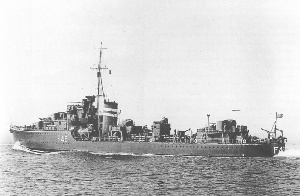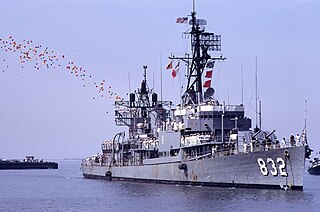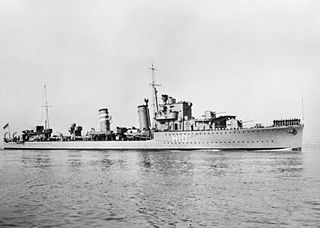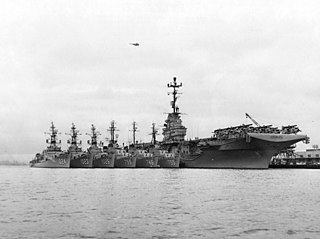
A warship or combatant ship is a ship that is used for naval warfare. Usually they belong to the navy branch of the armed forces of a nation, though they have also been operated by individuals, cooperatives and corporations. As well as being armed, warships are designed to withstand damage and are typically faster and more maneuverable than merchant ships. Unlike a merchant ship, which carries cargo, a warship typically carries only weapons, ammunition and supplies for its crew.

HMS Juno was a J-class destroyer of the Royal Navy laid down by the Fairfield Shipbuilding and Engineering Company, Limited, at Govan in Scotland on 5 October 1937, launched on 8 December 1938 and commissioned on 25 August 1939. Juno participated in the Battle of Calabria in July 1940 and the Battle of Cape Matapan in March 1941.

The Fleet Rehabilitation and Modernization (FRAM) program of the United States Navy extended the lives of World War II-era destroyers by shifting their mission from a surface attack role to that of a submarine hunter. The FRAM program also covered cruisers, aircraft carriers, submarines, amphibious ships, and auxiliaries. The United States Coast Guard also used this term in the 1980s for the modernization of its Hamilton-class cutters.

The Type 12 or Whitby-class frigates were a six-ship class of anti-submarine frigates of the Royal Navy, which entered service late in the 1950s. They were designed in the early 1950s as first-rate ocean-going convoy escorts, in the light of experience gained during World War II. At this time, the Royal Navy were designing single-role escorts and the Whitbys were designed as fast convoy escorts capable of tackling high-speed submarines. However, this made the Whitbys more expensive and sophisticated to produce in large numbers in the event of a major war, and so the Type 14 "utility" or "second-rate" anti-submarine frigate was developed to complement the Type 12. Although themselves rapidly outdated, the Type 12 proved to be an excellent basis for a series of frigate designs used by the British and Commonwealth navies for the next 20 years.

The Gearing class was a series of 98 destroyers built for the U.S. Navy during and shortly after World War II. The Gearing design was a minor modification of the Allen M. Sumner class, whereby the hull was lengthened by 14 ft (4.3 m) at amidships, which resulted in more fuel storage space and increased the operating range.

The Clemson class was a series of 156 destroyers which served with the United States Navy from after World War I through World War II.

The Wickes-class destroyers were a class of 111 destroyers built by the United States Navy in 1917–19. Together with the six preceding Caldwell-class and following 156 subsequent Clemson-class destroyers, they were grouped as the "flush-deck" or "four-stack" type. Only a few were completed in time to serve in World War I, including USS Wickes, the lead ship of the class.

The Allen M. Sumner class was a group of 58 destroyers built by the United States during World War II. Another twelve ships were completed as destroyer minelayers. The class was named for Allen Melancthon Sumner, an officer in the United States Marine Corps. Often referred to as simply the Sumner, this class was distinguished from the previous Fletcher class by their twin 5-inch/38 caliber gun mounts, dual rudders, additional anti-aircraft weapons, and many other advancements. The Allen M. Sumner design was extended 14 feet (4.3 m) amidships to become the Gearing class, which was produced in larger numbers but did not see significant service in World War II.

Garcia-class frigates were United States Navy warships. These frigates were originally ocean escorts bearing the hull classification DE until 1975. The ships were commissioned between 1964 and 1968 and decommissioned between 1988 and 1990.

The E and F-class destroyers were a group of 18 destroyers built for the Royal Navy during the 1930s. The ships were initially assigned to the Home Fleet, although they reinforced the Mediterranean Fleet during the Italian invasion of Abyssinia of 1935–36 and enforced the Non-Intervention Agreement during the Spanish Civil War of 1936–1939. After the beginning of the Second World War in August 1939, the E-class ships were mostly assigned to escort duties under the Western Approaches Command, while the Fs were assigned to escort the ships of the Home Fleet. Between them they sank four German submarines through March 1940 while losing only one ship to a submarine.

The Sampson-class destroyers served in the United States Navy during World War I. Commissioned in 1916 and 1917, the class was a modification of the O'Brien and Tucker classes, with the number of 21-inch (533 mm) torpedo tubes increased from four twin-mounts to four triple-mounts. The Sampsons were the final six ships of the 26 "thousand tonner" destroyers. They were the largest and most heavily armed of the "thousand tonners", and the subsequent "flush deck" classes differed mainly in hull design and the engineering plant.

The Caldwell class was a class of six "flush deck" United States Navy destroyers built during World War I and shortly after. Four served as convoy escorts in the Atlantic; the other two were completed too late for wartime service. Two were scrapped during the 1930s, but four survived to serve throughout World War II, three of these in service with the Royal Navy under the Destroyers for Bases Agreement and the fourth as a high speed transport.

Anti-submarine warfare is a branch of underwater warfare that uses surface warships, aircraft, submarines, or other platforms, to find, track, and deter, damage, or destroy enemy submarines. Such operations are typically carried out to protect friendly shipping and coastal facilities from submarine attacks and to overcome blockades.

The St. Laurent-class destroyer was a class of destroyer escorts that served the Royal Canadian Navy and later the Canadian Forces from the mid-1950s to the mid-1990s.

USS Carpenter (DD/DDK/DDE-825) was a Gearing-class destroyer of the United States Navy, named for Lieutenant Commander Donald M. Carpenter (1894–1940).
At the start of World War II, the Royal Navy operated a range of destroyer classes. Some of these were legacies of World War I, some were designed during the inter-war years and the rest were the result of wartime experience and conditions. British-built and -designed vessels were also supplied to and built by allied navies, primarily the Australian and Canadian navies.

Japanese destroyers of World War II included some of the most formidable destroyers of their day. This came as a surprise to the Allies, who had generally underestimated Japanese technical capabilities. The Japanese had reassessed their naval needs in the mid-1920s and, placing an emphasis on ship and weapons technology and night-fighting expertise, developed a completely new destroyer design. Subsequent development from one destroyer class to the next was not, however, a smooth progression. Aside from the usual changes arising from experience, serious design faults also came to light and naval treaties imposed restrictions. As a result, the early "Special Type" destroyers required significant changes and the specifications of subsequent classes was reduced in one way or another. Naval treaties were later abrogated in 1937 and so destroyer development continued without regard to limits.

HMS Vanoc was a British V-class destroyer, launched in 1917. The ship saw service in both the First and Second World Wars. During the First World War, Vanoc served as part of two destroyer flotillas, undertaking minelayer and convoy escort roles. In 1919, the destroyer took part in British operations in the Baltic as part of Allied efforts to intervene in the Russian Civil War. During the Second World War, Vanoc was involved in evacuation efforts to remove troops from Norway and France, and was utilised as a convoy escort, protecting convoys from German U-boats. In this role, Vanoc sank a German submarine, German submarine U-100 in March 1941 in the Atlantic, and assisted in the destruction of another, German submarine U-99. Three years later, Vanoc was involved in sinking U-392 in the Straits of Gibraltar in concert with a British frigate and several US anti-submarine aircraft. In January 1945, she was involved in a collision with another Allied vessel off Normandy, before being placed into reserve in June. She was later sold for scrap and was broken up after mid-1946.

Hunter-killer Groups, also known as Convoy Support Groups, were groups of anti-submarine warships that were actively deployed to attack submarines during World War II. The advances in signals intelligence such as high-frequency direction finding, in cryptological intelligence such as Ultra, and in detection technologies such as radar and sonar/ASDIC enabled the Allied navies to form flotillas designed to actively hunt down submarines and sink them. Similar groups also existed during the Cold War. A hunter-killer group would typically be formed around an escort carrier to provide aerial reconnaissance and air cover, with a number of corvettes, destroyers, destroyer escorts, frigates, and/or United States Coast Guard Cutters armed with depth charges and Hedgehog anti-submarine mortars.

The Dealey-class destroyer escorts were the first post-World War II escort ships built for the United States Navy.



















